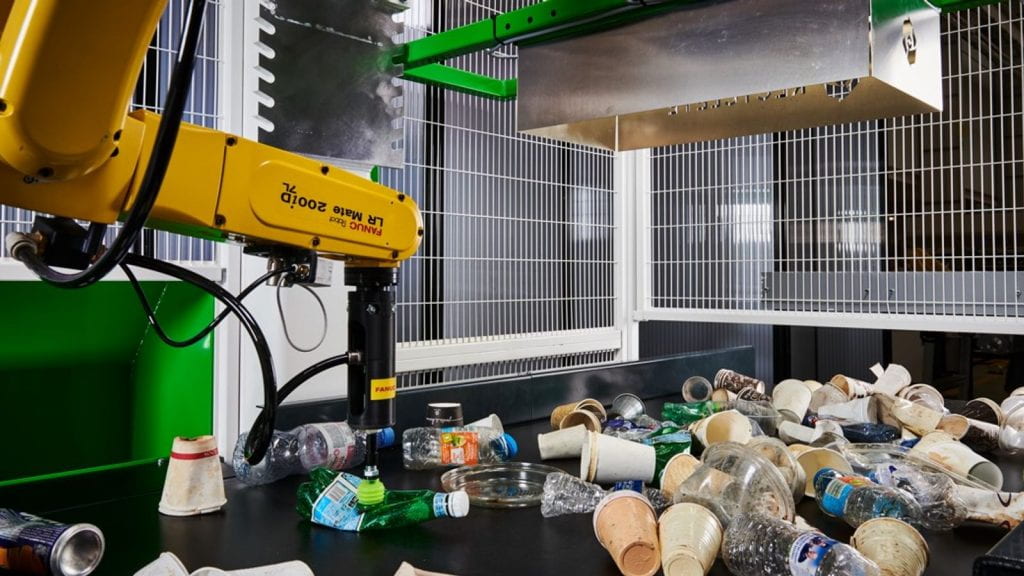
Credit: Recycleye
We know that mobile robots can be useful to address many environmental issues within several planetary boundaries. Yet, the use of non-mobile robots, or industrial robots, has typically been confined to industry work: manufacturing, production, automation. However, industrial robots can have many applications for a sustainable environment, as well, particularly—but not limited to—within the waste management sector.
When we recycle objects, they are sent to a facility to be sorted, cleaned, and processed into materials that can be sold like raw materials for manufacturing (EPA, 2020). To automate and accelerate this process, researchers are examining the efficacy of industrial robots with advanced manipulation, image processing, and vision properties.
- Many industrial arms, utilizes a “pick-and-place” (PnP) sorting technique, wherein the robot grasps an object, moves above the desired drop-off area, and places the object down onto it. However, a study published at the 2020 IEEE Conference on Automation Science and Engineering investigated a new transfer model for waste sorting using an ABB-IRB360 Delta robot—a parallel robot extensively used in the packaging industry and high-precision assembly operations [1]. This new transfer method, deemed “pick-and-toss” (PnT), was examined in simulation and also on a real waste sorting lab setup and it was proven to reliably extend the scope of the robot, reduce the time it takes to process recyclable items by 15.3%, and increase the processing capacity of the robot by 18% with the same accuracy as PnP [1].
To adapt the Delta robot so that it would be able to toss the objects it sorts, the team designed a vacuum gripping system that attached to the end-effector of the robot [1]. Then, as the robot moves from picking up an item to placing it in a sorting bin, the suction of the gripper is deactivated a given percent through the trajectory, releasing the item, and letting the inertia of the object’s motion carry it the rest of the way into the bin, creating the “toss” motion [1]. Then, the arm’s starting position for picking up the next recyclable item is much closer to the conveyer belt, shortening the time it takes to complete the overall sorting process [1]. While further testing and failure reduction studies are anticipated, this process could soon be applied to full-time industrial waste sorting environments [1]. - AMP Robotics located in Louisville, Colorado, USA, uses artificial intelligence and deep learning to recognize objects the same way a human does to sort recyclables with an accuracy rate of 99% (AMP Robotics, “Our Core Technology”, 2021). The company also produces a robotic waste sorting system called the AMP Cortex and a material characterization software called the AMP Clarity (AMP Robotics, “AMP Cortex”, 2021).
- Sadako Technologies has a very similar model to AMP Robotics; modeled with artificial intelligence and computer vision, the company produces two major applications: a robotic waste sorting system named Max-AI, and a waste stream monitoring system for the European Union called the RUBSEE project (Sadako Technologies, 2021).
- ZenRobotics has robotic sorting solutions for two separate types of waste: the Heavy Picker and the Fast Picker. Heavy Picker can grasp heavyweight and irregular-shaped waste that comes from Construction & Demolition Waste (CDW) while sorting several waste types (Commercial & Industrial Waste – CIW, Municipal Solid Waste – MSW, Plastic, Packaging, and Scrap Metal) simultaneously, and Fast Picker autonomously and continuously sorts lightweight materials (ZenRobotics, 2021).
| Ground Robotics | Marine Robotics | Aerial Robotics |
References:
[1] Robotic Pick-and-Toss Facilitates Urban Waste Sorting, Nandanwar & Rout, 2021; Raptopoulos et al., (2020)